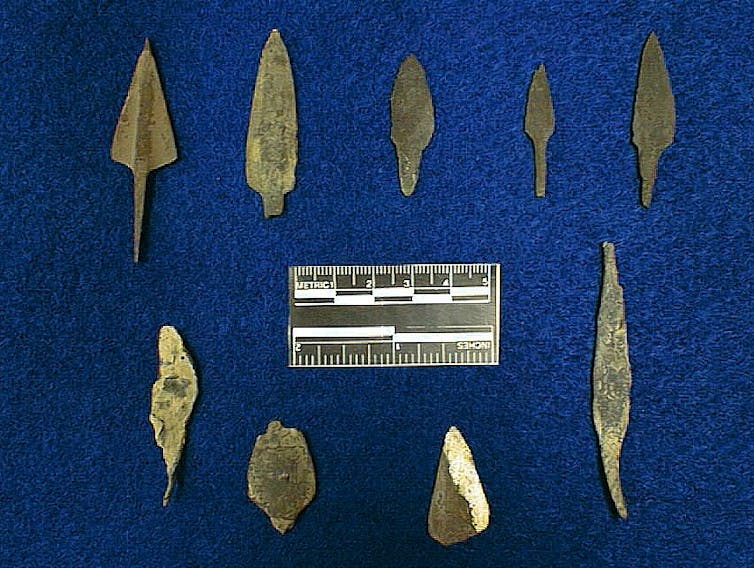The ancestors of Alaska Native people began using local copper sources to craft intricate tools roughly 1,000 years ago. Over one-third of all copper objects archaeologists have found in this region were excavated at a single spot, named the Gulkana Site.
This is the site I’ve studied for the past four years as a Ph.D. student at Purdue University. In spite of its importance, the Gulkana Site is not well known.
To my knowledge, it isn’t mentioned in any museums. Locals, including Alaska Native Ahtna people, who descend from the site’s original inhabitants, might recognize the name, but they don’t know much about what happened there. Even among archaeologists, little information is available about it – just a few reports and passing mentions in a handful of publications.

Copper projectile points from the Gulkana Site.
Hanson 1999 Interim Report of Archaeological Activities at the Ringling Material Site
However, the Gulkana Site was first identified and excavated nearly 50 years ago. What gives?
Archaeology has a data management problem, and it is not unique to the Gulkana Site. U.S. federal regulations and disciplinary standards require archaeologists to preserve records of their excavations, but many of these records have never been analyzed. Archaeologists refer to this problem as the “legacy data backlog.”
As an example of this backlog, the Gulkana Site tells a story not only about Ahtna history and copperworking innovation, but also about the ongoing value of archaeological data to researchers and the public alike.
What happens after an excavation?
In the United States, most excavations, including those that have happened at the Gulkana Site, occur through a process called Cultural Resource Management. Since the 1960s, federal regulations in the U.S. have required archaeological excavations prior to certain development projects. Regulations also require that records of any finds be preserved for future generations.
One estimate suggests that this process has created millions of records in the legacy data backlog. Archaeological data is complex, and these records include many file formats, varying from handwritten maps to pictures and spatial data.
The problem is worst for datasets that were created before computers were in common use. Research suggests that archaeologists are biased toward digital datasets, which are easier to access and use with modern methods. Ignoring nondigital datasets means not only abandoning the product of decades of archaeological work, it also silences the human experiences those datasets are meant to preserve. Once a site is excavated, this data is the only way the people who lived there can tell their story.
Archaeologists aren’t sure how to resolve this problem. Many solutions have been proposed, including the creation of new data repositories, making new use of existing datasets whenever possible, and increasing collaboration with other…



